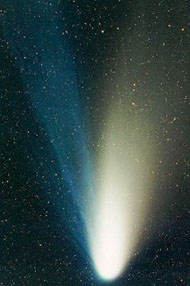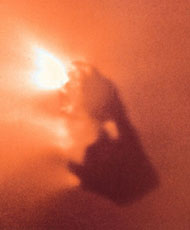
![]() Main Page
Main Page
![]() Feedback
Feedback
 The Author
The Author
 News
News
 Search
Search
 The Planets
The Planets
 Mercury
Mercury
 Venus
Venus
 Earth
Earth
 Mars
Mars
 Jupiter
Jupiter
 Saturn
Saturn
 Uranus
Uranus
 Neptune
Neptune
 Pluto
Pluto
 Dwarf Planets
Dwarf Planets
 The Solar System
The Solar System
 The Sun
The Sun
 The Moon
The Moon
 Meteors
Meteors
 Comets
Comets
 Asteroids
Asteroids
 Amazing facts
Amazing facts
 Other
Resources
Other
Resources
 Poster Store
Poster Store
 Multimedia
Multimedia
 Links
Links
 Awards
Awards
 Glossary
Glossary
 Astronomers
Astronomers
 Webrings
Webrings
 Bibliography
Bibliography
Comets
More Images of Comets Here |
Print this information out Here |
|||||||||||||
|
What is a Comet? From the ground, comets look like small, white streaks of light hanging motionless and calmly in the night sky. In reality they're bulky objects hurtling through space at unimaginably fast speeds. Many years ago people used to think that comets were huge balls of fire. However we now know that in reality they are solid, frozen, lifeless cosmic icebergs. Furthermore, they would be dark and invisible, if it were not for the heat of the Sun causing them to shine and develop their distinctive tails. The Origin of Comets
Scientists believe that most comets in the Solar System come from the Oort cloud - a ring of around 10 trillion icy objects which resides around our Solar System, far beyond Pluto's orbit, halfway between the Sun and our closest stellar neighbour (that is about 100,000 Au or 2 light years away). A comet can easily be dislodged however (for example under the influence of a passing star), and may then come hurtling into the Solar System. Attracted by the Sun's gravity, it would accelerate towards the Sun, building up speed and eventually travelling extremely fast when it reaches the planets. The potential for damage upon impact with a planet is therefore very real, as was shown when comet Shoemaker-Levy 9 crashed into the surface of Jupiter in July 1994. Most of the time they just zip around the Sun and then back into outer space, but occasionally they get trapped by Jupiter's gravity and make repeated visits to the Solar System (eg Halley's comet - see below) until they finally evaporate. Head and Tail We here on Earth can only see them when they come close to the Sun. This is because although they themselves do not generate any light, when they approach the Sun that they develop large tails of luminous material. When a comet becomes hot enough and its nucleus unfreezes, a coma develops and the gas inside it absorbs ultraviolet light, giving it a bright blue look. When a comet gets close to the Sun in fact, its 'head' encompasses a small bright nucleus, typically about 10km in diameter, surrounded by the coma. Contrary to intuition, comets' tails don't point in the direction they're travelling from, instead they always point away from the Sun. This is because the dust and rock fragments which make up the comet's tail get 'blown' in this direction by the Solar Wind.
Halley's Comet and Shoemaker-Levy 9 Probably the most famous comet, and certainly the most studied, is Halley's comet - named after Edmund Halley, the man who not only worked out that some comets actually orbit the Sun, but also figured out that a comet he was observing (later named Halley's comet) was in a solar orbit and would reappear every 76 years. He was right, and some evidence suggests that William the Conqueror saw it back in 1066. The last time it appeared was a little closer though, in 1986 and it is therefore scheduled again in 2062. When it appeared in the mid 1980s, many space craft were sent to the comet, gathering extensive data upon which much of our cometary knowledge is now based. Halley's Comet's nucleus was the first to be imaged, from relatively close up, by the Giotto spacecraft. Comet Shoemaker Levy 9 (officially designated D/1993 F2) is another very famous comet of recent times. As mentioned above, in July 1994 it collided with Jupiter, an event watched by hundreds of excited Astronomers from their telescopes on Earth. So great is Jupiter's gravitational field that the comet was actually torn apart into many pieces before it plunged into the Jovian atmosphere. Nontheless, it still produced visible scars on Jupiter's surface which took days to clear up. |
||||||||||||||
Comets Links |
||||||||||||||
|
||||||||||||||


